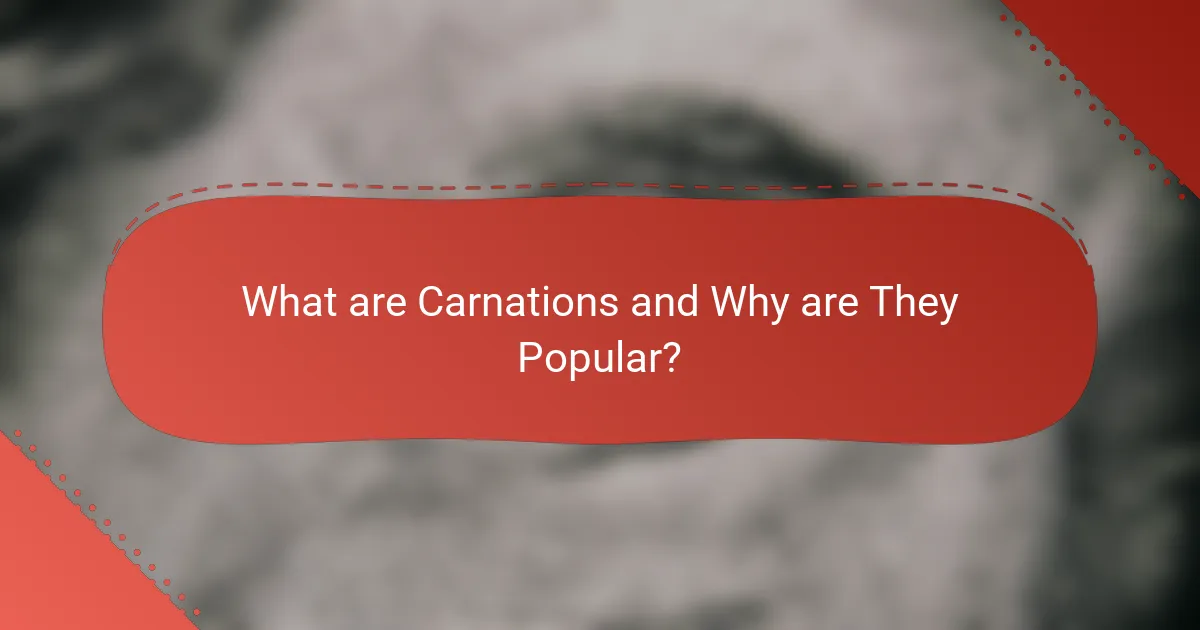
What are Carnations and Why are They Popular?
Carnations are flowering plants belonging to the genus Dianthus. They are known for their frilled petals and wide range of colors. Carnations symbolize love and fascination, making them popular in floral arrangements. Their longevity as cut flowers is another reason for their popularity. Studies show that they can last up to three weeks in a vase. Additionally, carnations are often used in celebrations and ceremonies. Their versatility in floral design contributes to their appeal. The historical use of carnations dates back to ancient times, enhancing their cultural significance.
What are the different colors of Carnations?
Carnations come in a variety of colors. Common colors include red, pink, white, yellow, and purple. Each color has its own significance and usage. For example, red carnations symbolize love, while white carnations represent purity. Additionally, there are striped and multicolored varieties. These colors are achieved through selective breeding and genetic variations. Carnations are widely cultivated globally for their diverse color palette.
How do the colors of Carnations symbolize different meanings?
The colors of carnations symbolize different meanings based on cultural associations and historical contexts. For example, red carnations represent love and admiration. Pink carnations convey a sense of gratitude and a reminder of a loved one. White carnations symbolize purity and good luck, often used in weddings. Yellow carnations indicate disappointment or rejection. Each color has a specific emotional connection, which has been recognized in floral traditions worldwide. This symbolism is reinforced by historical practices, such as their use in various ceremonies and celebrations.
What are the most common varieties of Carnation colors?
The most common varieties of carnation colors include pink, red, white, yellow, and purple. Pink carnations are often associated with a mother’s love. Red carnations symbolize admiration and deep love. White carnations represent purity and good luck. Yellow carnations convey cheerfulness and friendship. Purple carnations are linked to capriciousness and whimsy. These colors are widely available and popular in floral arrangements. Carnations are known for their vibrant hues and long-lasting blooms.
How long do Carnations typically last?
Carnations typically last 7 to 14 days when cut. This longevity depends on proper care, such as fresh water and appropriate temperature. Studies indicate that keeping carnations in a cool environment can extend their lifespan. Regularly changing the water and trimming the stems also helps maintain their freshness.
What factors influence the longevity of Carnations?
The longevity of carnations is influenced by several key factors. These include water quality, temperature, and light exposure. Fresh water with the right pH level can prolong their lifespan. Carnations thrive in cooler temperatures, ideally between 60-70°F. Excessive heat can cause wilting and reduce longevity. Proper light exposure is also essential; indirect sunlight is preferable. Additionally, the age of the flower at purchase affects its lifespan. Younger blooms tend to last longer than older ones. Lastly, the presence of ethylene gas can shorten the life of carnations, so avoiding exposure is crucial.
How can you extend the lifespan of cut Carnations?
To extend the lifespan of cut Carnations, change the water daily. Fresh water helps prevent bacterial growth. Trim the stems at an angle before placing them in water. This increases water absorption. Remove any leaves that are submerged in water. Submerged leaves can rot and cause bacteria. Use a clean vase to avoid contamination. Adding flower food can provide essential nutrients. Keep the flowers in a cool environment away from direct sunlight. This slows down the aging process. Following these steps can extend their lifespan significantly.
What are the historical uses of Carnations?
Carnations have a rich history of use in various cultural and social contexts. Historically, they were used in ancient Roman and Greek ceremonies. These flowers symbolized love and fascination. In the Middle Ages, carnations were incorporated into religious art and decorations. They were often featured in paintings to symbolize divine love. During the Victorian era, carnations were used to convey specific messages in the language of flowers. For example, a pink carnation represented a love that was eternal. Additionally, they were popular in corsages and boutonnieres for formal occasions. Today, carnations are widely used in floral arrangements and celebrations, maintaining their significance in various traditions.
How have Carnations been used in traditional medicine?
Carnations have been used in traditional medicine for their anti-inflammatory and analgesic properties. Historically, these flowers were applied topically to treat skin irritations and wounds. The petals were often brewed into teas for digestive issues. Additionally, they were utilized in herbal remedies to alleviate headaches. Some cultures believed carnations could help reduce fever. The use of carnations in medicine dates back to ancient times, reflecting their historical significance. Ethnobotanical studies support these medicinal applications, highlighting their role in folk medicine.
What cultural significance do Carnations hold in various societies?
Carnations hold significant cultural meaning in various societies. In many cultures, they symbolize love and fascination. For instance, in the United States, red carnations represent admiration and deep love. In contrast, white carnations are often associated with purity and good luck. In some European countries, such as Spain, carnations are linked to the celebration of festivals and are used in traditional dances. Additionally, in Chinese culture, carnations symbolize a long life and are often used in celebrations. The cultural significance of carnations varies by color and context, reflecting diverse beliefs and traditions across societies.
How do Carnations connect to modern floral arrangements?
Carnations are integral to modern floral arrangements due to their versatility and wide range of colors. They can be used in various styles, from casual bouquets to formal centerpieces. Their long-lasting nature makes them a favorite among florists and consumers alike. Carnations can retain freshness for up to three weeks, surpassing many other flowers. This longevity allows for extended enjoyment in arrangements. Additionally, they are cost-effective, making them accessible for various occasions. The adaptability of carnations to different themes enhances their appeal in modern design. Their ability to complement other flowers also contributes to their popularity in mixed arrangements.
What are the best practices for caring for Carnations in gardens?
The best practices for caring for carnations in gardens include providing well-drained soil and full sunlight. Carnations thrive in soil that is rich in organic matter. Watering should be consistent but not excessive to avoid root rot. Pruning spent flowers promotes new growth and extends blooming. Fertilizing with a balanced fertilizer every four to six weeks supports healthy development. Additionally, protecting carnations from pests like aphids and spider mites is crucial. Regular inspection helps identify and manage any infestations early. These practices ensure vibrant blooms and robust plants throughout the growing season.
How can you propagate Carnations effectively?
To propagate carnations effectively, use stem cuttings. Take cuttings from healthy, non-flowering stems. Each cutting should be about 4-6 inches long. Remove the lower leaves from the cuttings. Dip the cut end in rooting hormone to encourage root growth. Plant the cuttings in a well-draining potting mix. Water the cuttings lightly to keep the soil moist. Cover the cuttings with a plastic bag or a clear container to maintain humidity. Place them in a warm, bright location but out of direct sunlight. Roots should develop in about 2-4 weeks.
What are common pests and diseases that affect Carnations?
Common pests that affect carnations include aphids, spider mites, and thrips. Aphids suck sap from the plant, weakening it and causing leaf distortion. Spider mites create fine webs and cause yellowing of leaves. Thrips damage flowers and leaves by feeding on plant tissue.
Diseases that commonly impact carnations include gray mold, powdery mildew, and root rot. Gray mold, caused by Botrytis cinerea, thrives in moist conditions and leads to wilting and decay. Powdery mildew appears as a white powdery substance on leaves and stems, stunting growth. Root rot, often due to overwatering, results in wilting and plant death.
These pests and diseases can significantly affect the health and appearance of carnations. Regular monitoring and appropriate care can help manage these issues effectively.
What tips can you use for choosing and arranging Carnations?
Choose fresh carnations with firm petals and vibrant colors. Look for flowers that are free from blemishes and wilting. Select a variety of colors to create visual interest in arrangements. Use a sharp knife to cut stems at an angle for better water absorption. Remove any leaves that will be submerged in water to prevent bacterial growth. Arrange carnations in a clean vase with fresh water and flower food. Place taller stems in the center and shorter ones around the edges for balance. Change the water every few days to prolong their freshness.
Carnations, belonging to the genus Dianthus, are popular flowering plants known for their frilled petals and diverse color range, symbolizing love and fascination. This article explores the different colors of carnations, their meanings, and the factors influencing their longevity as cut flowers. It also delves into the historical uses of carnations, their cultural significance, and best practices for care in gardens. Additionally, tips for selecting and arranging carnations are provided, along with information on common pests and diseases that affect them.
